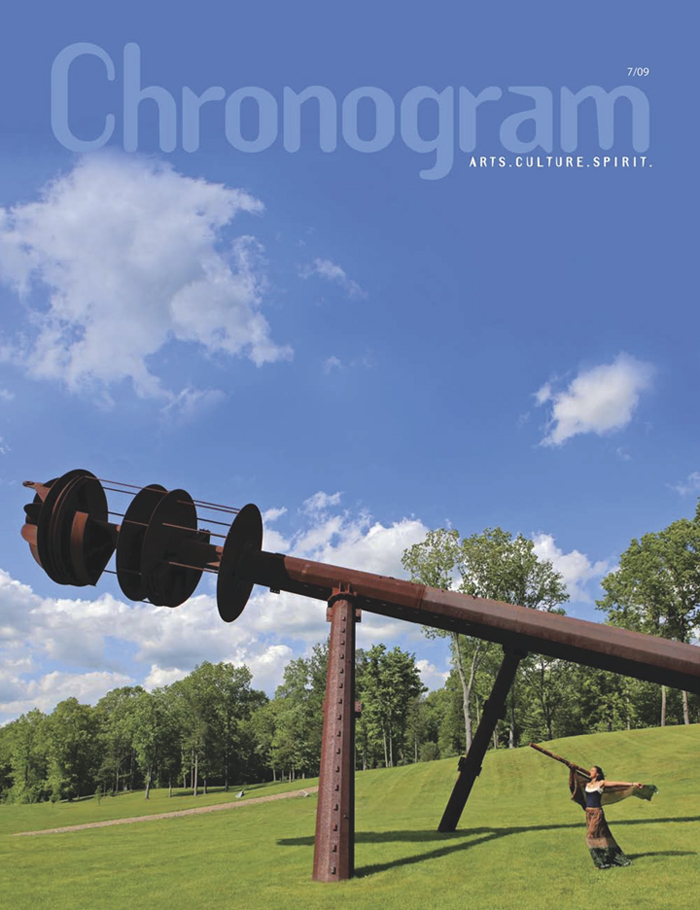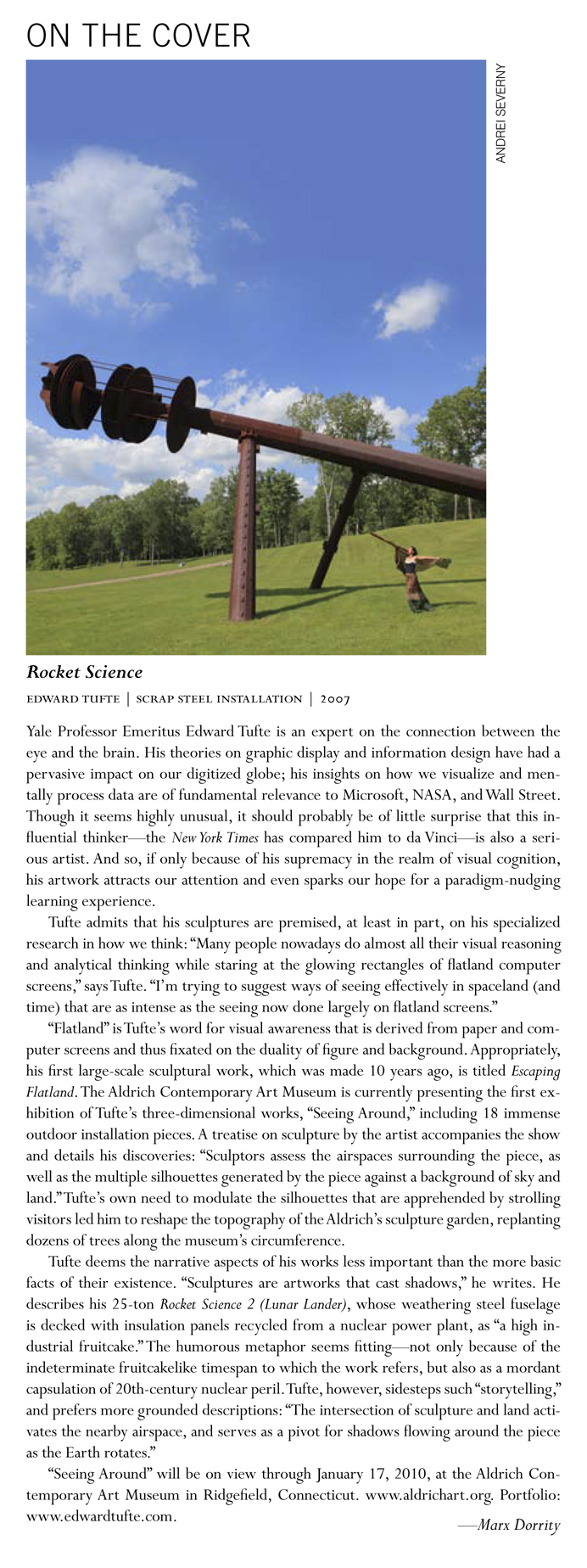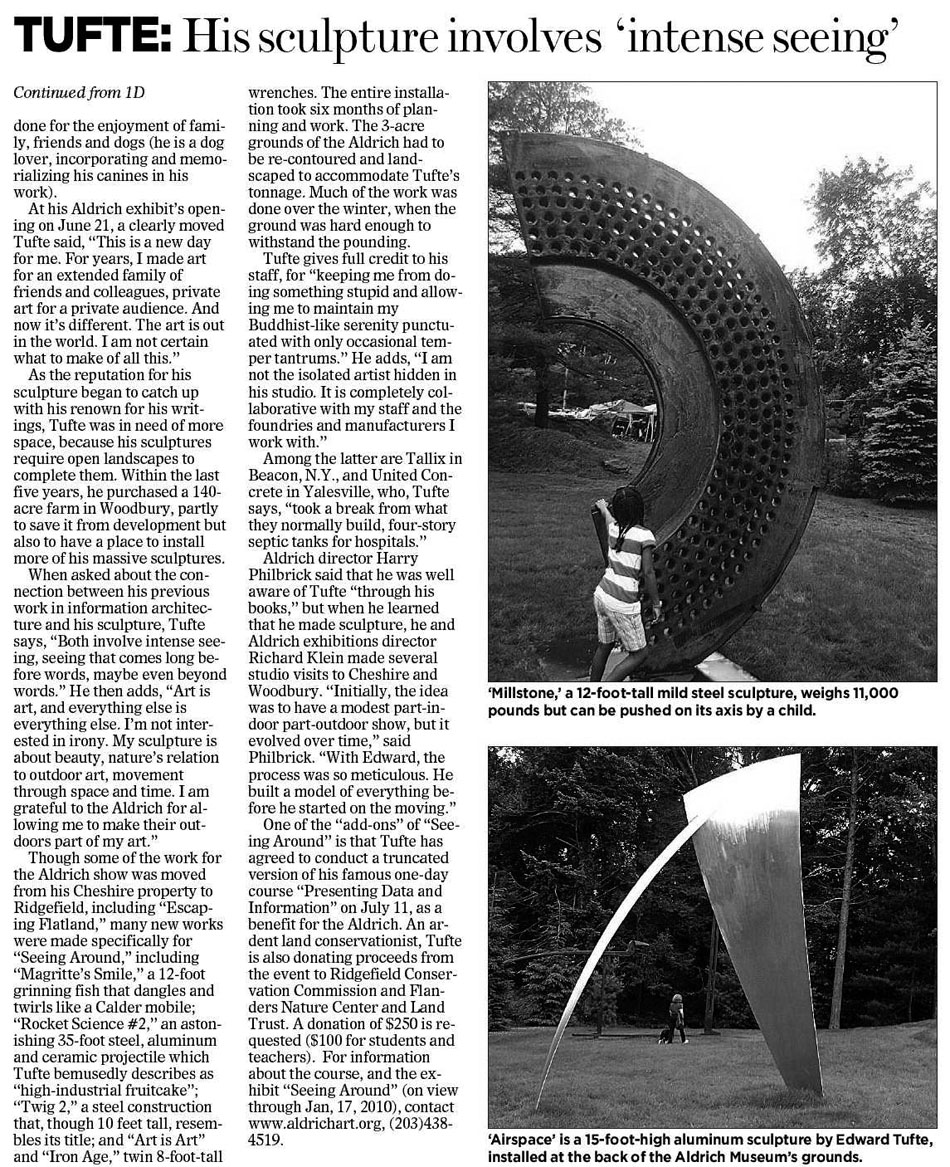|
All 5 books, Edward Tufte paperback $180
All 5 clothbound books, autographed by ET $280
Visual Display of Quantitative Information
Envisioning Information
Visual Explanations
Beautiful Evidence
Seeing With Fresh Eyes
catalog + shopping cart
|
Edward Tufte e-books Immediate download to any computer: Visual and Statistical Thinking $5
The Cognitive Style of Powerpoint $5
Seeing Around + Feynman Diagrams $5
Data Analysis for Politics and Policy $9
catalog + shopping cart
New ET Book
Seeing with Fresh Eyes:
catalog + shopping cart
Meaning, Space, Data, Truth |
Analyzing/Presenting Data/Information All 5 books + 4-hour ET online video course, keyed to the 5 books. |
Response to ET sculpture interviews and news
For this interview in Modern Painters (Summer, 2009, p. 12), Lyra Kilston asked
some good questions, recorded and edited my answers, and then sent me the text to
revise and edit. Thus the quotes are a bit more articulate and thoughtful than usual,
although the informality of spoken answers to questions is still present. I'm grateful
to Lyra Kilston for doing this article.
 |
Source: Modern Painters, Summer 2009
-- Edward Tufte
Audience and Agency
Congratulations on this much deserved opportunity to display your work, passion and genius to the public in such a classic way!
It seems to me that your sculptures illuminate one aspect of your information design that is not immediately obvious in flatland and that carries a distinct philosophical import: the object of your design, and perhaps design in general, is not the information or the sculpture, but the agent that comes into comes into contact with it (the user of the interface, the sheep in the pasture, the museum visitors). I would say that your art (and certainly your design) is decidedly effective - it seamlessly integrates with the nature and capabilities of its audience to the point of being a shadow of it. This makes me think that good design enforces a sense of identity between it and the agents that come into contact with it. Good design is a metaphor for the agents themselves.
I'd like to know whether you see your art this way and if you have anything to add to this reading of your design techniques.
Thanks!
Jarrod Dungan
-- Jarrod Dungan (email)
Sense of audience
I've never been a fan of the "know your audience" doctrine in making presentations. Too often, this approach leads to underestimating the audience and sometimes to pandering. Better, presenters should know their content and respect their audience. That's what good teachers do, I believe.
At high levels of creative work that is going to last and have long-run consequences, probably the view of some creators is that the audience can take it or leave it, that if you're not doing something different you're not doing anything at all, that you should do the best you can and put it out to the world and hope for the best. One of Richard Feynman's books is entitled "What do you care what other people think?", a remark made by his mother.
Where the audience comes in, for me, is that I try to reduce impediments to seeing and understanding my work: I try to write clearly, to design books so as to eliminate glitches in getting to my material, to create an elegant argument and visual experience, to remain reasonably civil or at least politely blunt, to avoid the first-person singular, to make it easy for people to see my work, to have vivid summaries, to teach a lot of one-day courses about my work, and to make subtle jokes (often, alas, so subtle that only I recognize them and think them funny). Easing the impediments to access for my audiences has no negative consequences for the quality of the intellectual content.
In reading drafts of my writing, I sometimes try to read through the eyes of selected friends: "What would Fred Mosteller (a Harvard statistician) think about this?" "What would Bob Merton (Columbia sociologist) think about this?" Years ago, they read various manuscripts of mine and made helpful comments. They were also scholar's scholars.
Most of the time my user-testing research involves a sample size of one, myself. I set something aside for a while and try to look at it with fresh eyes, a technique that has revealed murky logic, and over-reliance on brilliant examples or smark-alec quotes (from others) that turn out to be, upon reflection, not quite apt. As noted elsewhere on this board, I'm not a fan of focus groups and human factors approaches to high-level design (raises the floor by heading off disaster, but doesn't help much to raise the ceiling above mediocrity).
In making art, I have never thought or cared much about an audience, the art market, or what other people (outside of my extended family) think. In locating the sculpture at the Aldrich Contemporary Art Museum, I walk around a lot, try to detect impediments to viewing, and seek to increase the number of friendly and diverse paths through the pieces and around the sculpture garden. But again, an N = 1. In making or installing a sculpture, sometimes I'll ask a nearby colleague what they think, just to have something to play off against in my seeing. In the welding shop, I have a long running story-telling joke that we're making this piece for our client Ms. Nefertiti and that we need to create the illusion that it is really difficult and time-consuming for us to make art (which it is not at all) and that the piece required 200 hours of computing with Frank Gehry's super-duper 3D computer modelling program blah blah blah. She's the only client I've ever thought about.
On the other hand, the threat of having a public sculpture show that started, no matter what, on such-and-such a date, has proved enormously stimulating to my sculptural work. Never been more productive in more diverse ways than in the last 18 months since I was offered the Aldrich show. But the effect is on rapidity of making new pieces not on the kinds of sculpture constructed.
Finally I have largely avoided making editions or near-duplicates of my sculptures, since that puts me in the business repeating myself rather than doing new work.
None of the above is meant as advice to anyone else; it is merely description of what I do, an N = 1.
-- Edward Tufte
After Modern Painters, The Cheshire Herald
 |
-- Edward Tufte
Cover picture of Rocket Science 1 and Dancer!
 |
 |
Click here for the July issue of Chronogram
-- Edward Tufte
New York Times
Susan Hodara, "A Master of Two Dimensions, Plus One,"
http://www.nytimes.com/2009/07/05/nyregion/05spotct.html
-- Edward Tufte
 |
-- Edward Tufte
|
||||||||||||||||||||||||||||||||||||||||||||||||||||||||||||||||||||||||||||||||||||||||||






